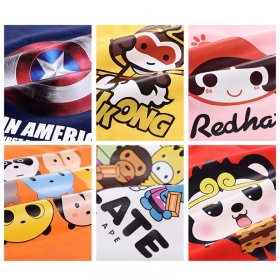 " />
" />
Jersey cloth screen printing heat transfer sticker, it is produced by screen printing and used for jersey.
 " />
" />
Flock heat transfer sticker , it is produced by screen printing. It can be within 4 colors and eco-friendly. It is usually applied for all types of fabric like t-shirt, bags, kid’s clothes etc.
 " />
" />
Children’s wear offset printing heat transfer sticker, it is produced by offset printing. It can be colorful and eco-friendly. It is usually applied for all types of kids’ wear like cotton, nylon etc.
2025-05-22
Paste printing widely used in clothing,fit for a variety of dark-colored material printing, can printing in cotton, linen, viscose, polyester, nylon, polypropylene, vinyl chloride and all kinds of fiber blended fabric. Printing paste coverage is very good, it can make dark clothes printed on any light-colored, and have a certain gloss degree and three-dimensional sense, make clothing looks more upscale. Therefore, printing paste can quickly spread in a short period of time, it’s almost used on every printed T-shirt. Paste and water slurry combination can solve large area printing problem. Paste printing process overcome the water slurry printing limitations, but because of printing paste have a certain hardness, so it’s not suitable for large areas ground pattern, a large area pattern is best to use water slurry to printing, and then embellishment some paste. This can not only solve a large area hard paste problem, but also can highlight the pattern hierarchy. There is also another way to hollowed out a large area of ground pattern, made of rotten effect, but wear always feel a little bit hard, so it’s best to use water slurry and paste combination, to jointly solve the large area printing problem. Analysis advantages and disadvantages about paste printing and dye printing. On the choice about paste printing or dye printing, which in academic and actual production is a long-standing debate problem. According to incomplete statistics, currently used in printing 55% is paste and 45% is a dye. Including 20% is reactive dyes, 20% is disperse dyes, vat dyes and other accounts for 5%. (1) Dye printing will produce more wastewater, paste printing normally don’t wash water, so it will not produce wastewater. (2)Dye printing has a good hand feel and good air permeability advantage, especially in printing large area pattern more prominent. Dye-printed clothes are not only wear comfortable but also less cost. The disadvantage is complex process, many devices, compared with mortar printing simple process and less equipment. On the carcinogenic side, dangerous varieties exist in both dyes and coatings,some paste is actually insoluble in the dye, so both exist selection problem. (3) In paste printing binder is the key agent, whether in fastness or safety aspect, still far from perfect. In dye printing the most amount used reactive dyes, in the fixing rate and prevent broken keys also exist more deficiencies, sometimes can’t meet wear requirements.
Read More2025-05-22
Heat transfer ink in heat transfer printing have a key position, ink various properties are very important to product production,among them ink viscosity is more important. Viscosity refers to ink flow fluid in the process,fluid intermolecular interactions will produced hinder molecules relative movement ability measure.It reflects a property of fluid layers in the ink to stop each other flowing and ink itself resistance to flow ability,its essence is ink cohesion (intermolecular binding) strong and weak performance.High viscosity, ink has high cohesion, ink mobility is lower. Affecting viscosity has many factors, including the amount of pigment, oil absorption and fineness, linkers viscosity, fillers. The following introduce the pigment amount, oil absorption and fineness degree to viscosity extent impact. For the same type of binder, the greater proportion of pigment, the greater force between molecules,ink viscosity is large, but pigment in the ink amount is limited. Oil absorption refers to a certain amount of pigment wetting to form a slurry need to adsorption oil amount (g / 100g),is a description about pigments and greases binding ability. Under normal circumstances, the higher pigment dispersion, small particles, the pigment is larger than surface area,oil absorption is large, ink viscosity is small, fluidity increased. In addition, oil absorption is related to pigment moisture, oil acidity. Pigments containing more water, oil volume is low; oil acidity increased, pigment oil absorption will be reduced. Ink have a good fineness, indicating that solid particles is very fine, evenly distributed in the ink. Ink fineness depends on bonding material for pigments ect solid particles wetting degree, ink agitation, grinding and other processes handle degree.Bonding material has a strong wetting properties, pigments and solid particles easily wetted, the solid particles easily dispersed, after rolling the ink has a good fineness. Normally, pigments solid particles are present in fine particles flocculated state. Pigment particle size and dispersion state for ink viscosity, adhesion, fluidity and other rheological properties have a certain impact. Pigment particles should be controlled between 0.5-3um, however below 1um pigment particles should be accounted for 80-100%. In the same amount of pigment and filler circumstances, two kinds of solid powder particles are smaller, the higher dispersion, the more fully wetting in the ink binder, ink viscosity is relatively large, made of circular ink pigment particles compared with other shapes made of ink particles, its viscosity is smaller. transfertagfactory heat transfer ink can choose a lot of pigments, such as fluorescent yellow, lemon yellow, ultramarine, dark blue, silver and so on.
Read More2025-05-22
Hot melt adhesive is a plasticity adhesive products, hot melt adhesive in a certain temperature range its physical state changes with temperature changes, however the chemical properties is the same, hot melt adhesive particles non-toxic and tasteless, belongs to environmentally friendly glue products,can be used for various industries packaging aspects. So how do we choose the right hot melt adhesive particles? From the color, temperature, operations methods and many other aspects to consider. First we say gule color requirements should be different. Hot melt adhesive on the object appearance treatment not strict than other adhesive, but the objects appearance dust, oil should also be properly handled, in order to make hot melt adhesive particles better display bonding effect. Fast operation is a major feature of hot melt adhesive. Hot melt adhesive work time is generally about 15 seconds, with the modern mode production - assembly line extensive use, for hot melt adhesive working time is require more and more shorter. Another is the anti-temperature, hot melt adhesive is more sensitive to the temperature. When the temperature reaches a certain level hot melt adhesive begins to soften, below a certain temperature, hot melt adhesive will become brittle, so select hot melt adhesive must take full account product located temperature changes. If the temperature is too high, then you can choose high temperature hot melt adhesive. Hot melt adhesives particles are generally used hot melt machine through the heat melting hot melt adhesive, after melting glue is becoming liquid. Through hot melt hose and hot-melt adhesive gun, delivered to the adhesive appearance,when hot melt adhesive is cooling down,that is, completed the bonding.
Read More2025-05-22
Defoamers are produced by transfertagfactory company have a superior performance,and mainly used for heat transfer printing paste defoamers,with excellent defoaming, and antifoaming effects, which can restrain and eliminate paint application during production, canning and printing process generated bubbles. Defoamers are mainly used for thinner inks.These inks most can be delivered by a pump. During this process, a large amount of air may be mixed and may appear bubbles. In addition, during printing process, these thin ink scraped from the plate or down from the roller, due to impact between the ink, stirring, also produced a large number of bubbles. Aromatic, alcohol, water-based inks all have this phenomenon, while the latter is the most serious, because the latter are mostly alkali-soluble substances, it’s like soap (or detergent) in the water, so foam is very strong . Ink bubbles not only reduce the printed matter quality, but also, seriously ink fountains will produce a large number of bubbles, lead to printing can’t go on. 1)bubbles formation and destruction a brief mechanism. Bubbles, that is, gas into group by the liquid membrane wall surrounded by separation formed .Bubble walls themselves can form very uniform geometries, forming 120 degrees when three bubble walls (films) meet together. At least two or more components can form bubbles (pure liquids can’t foam), because foams require a large amount of surface area, production these surfaces is countered by the liquid surface tension. Therefore, when the liquid surface tension is relatively low, formation a certain amount of stable bubbles required energy is relatively low. When a single-molecule film surfactant-soluble appears on liquid surface, bubbles will generated. Liquid surface elasticity can also cause bubbles. In general, bubbles is not stable, its destruction is generally due to liquid from bubble wall squeeze into the wall edge to occur it,when membrane wall squeezed to a thickness about 100Ao,molecular motion in the membrane wall is to rupture the bubble structure by destroying liquid membrane. 2)Defoamer function. Defoamers are generally used to eliminate air bubbles through chemical reactions (such as acid or calcium salts can destroy soap film). However, most of defoamers function are spread out on the foam surface, so that surfactant on the bubble before stabilizing effect is removed or replaced,which requires a surface tension smaller than the original bubble-forming film surface tension. If the foam forming agent is easily desorbed and quickly reprocessed, then its effectiveness against defoamers is very small. If the foam desorption function is poor, the surface viscosity is relatively high, the anti-foaming agent spread slowly. A good anti-foaming agent should work very fast. Generally speaking, it should have very low solubility,and have a certain reduce surface tension liquid function.The most effective defoamer chemical structure should be: When it is oriente...
Read More